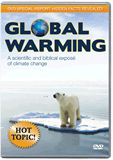
The End of Global Warming?
A century ago, scientists feared global cooling. Now they fear global warming. What do the numbers really show us?
Global cooling is the talk of the town. “Will we slip into another Ice Age?” “Will the earth be able to support its population if the global temperatures continue to drop?” “Could increasing carbon dioxide emissions save the day by offsetting the cooling?”
You might think this is a parody of the current global warming discussion. However, global cooling truly was a serious concern at the end of the 1800s. The figure at the center of the controversy was Svante Arrhenius, a Swedish chemist who was the first to investigate the effects of carbon dioxide (CO2) on climate. In a famous 1896 paper, he proposed that increasing CO2 gas in the atmosphere would increase surface temperatures (now called the greenhouse effect). The gas absorbs some of the infrared radiation from the earth and redirects it back to the surface, adding to the earth’s heat.
Arrhenius’ opponents claimed that CO2 has already reached its maximum impact (called a saturation point), and any increase would have no significant impact.
What does this century-old debate have to do with us today? Revisiting these still-unresolved questions may prevent modern politicians from making one of the greatest mistakes in our times.
Revisiting these still-unresolved questions may prevent modern politicians from making one of the greatest mistakes in our times.
In a December 2015 meeting in Paris, 195 countries adopted the first-ever legally binding agreement to limit CO2 emissions. The agreement attempts to limit global warming to below 2°C (3.6°F) above pre-industrial temperatures. It enters into force in 2020, at an estimated cost of hundreds of billions of dollars per year.
News reports going into this conference stated that this may be the last chance to limit the most serious effects of global warming. But is the situation that dire?
The difference between the earth’s annual temperature and the average for the past century has been documented (Figure 1). We can see why Arrhenius’ contemporaries were worried about global cooling. If the trend between 1880 and 1910 had continued, by 1980 global temperatures would have plummetted to values not seen since the Little Ice Age (1300–1850), which wreaked havoc on Europe’s growing seasons and caused the river Thames in England to freeze over. Fortunately, a warming trend began. In the last two decades this trend has flattened out, worrying some that global cooling may be on the horizon once again.
Although Arrhenius’ theory seems to explain the warming trend for most of the twentieth century, why have the temperatures plateaued if CO2 levels continue to go up? The following is a short summary of proposed answers.
Volcanoes
It is well established that volcanic eruptions send aerosols into the atmosphere, and these cause cooling. In 1815 Tambora provided the largest eruption on record and led to the Year Without a Summer. However, eruptions have a short-term impact, and no significant eruptions have occurred in the last two decades.
Sunspot Activity
During the coldest portion of the Little Ice Age, sunspots were missing for a long period, called the Maunder Minimum. In recent decades sunspot activity has declined, suggesting that the plateau in global temperatures is tied to sunspots. If true, this connection is somewhat mysterious because the sun’s energy output changes less than 0.1% (one tenth of one percent). Sunspot activity has been connected to changes in the earth’s cloudiness, but additional studies have shown that this could affect global warming by at most 10%.
Natural Cycles
Ocean and air currents, which distribute heat around the earth, can shift direction over the years. The overall effect can combine to give abnormally cold winters or hot summers. The best-known cycle is El Niño, which is a shift in the position of the Pacific Ocean’s warmest water near the equator. El Niño has a significant impact on temperature, which led to the record global high in 1998. (If the temperature for 1998 were removed from Figure 1, it is not clear that a temperature plateau exists over the past two decades.)
New Equilibrium
If CO2 is causing global warming, it will eventually reach a saturation point, and temperatures will level off at a new equilibrium.
The earth is a system of complex interactions that tend to balance out.
The last point needs more explanation. The earth is a system of complex interactions that tend to balance out (called equilibrium). Suppose water is flowing into a plastic bottle with different holes punched around the sides. If the amount of water increases, the level of water will rise, but the water will also stream out the holes faster. The level of water will rise until it reaches a new, stable level where the amount of water entering the bottle equals that which is leaving.
In a similar manner energy enters the earth through sunlight and leaves through infrared radiation from the earth. Adding CO2 traps some energy, but more energy also begins leaking out of the earth’s atmosphere through radiation as the temperature rises. Eventually the temperature will stabilize at a new equilibrium.
Could the temperatures over the past decades indicate that the earth has reached a new equilibrium? Possibly, but then maybe not. El Niño is strengthening, and the measurements for 2014 and 2015 indicate that temperatures may resume the warming trend.
Is the world cooling? We will be sure only after it has occurred as the years pass.
Even if we can hope for a new equilibrium, will we be happy with the new setting of the earth’s thermostat? It may not be good for everyone. God calls us to be good stewards of our resources, so the prospect of equilibrium has not absolved us of responsibility. We have nonscientific factors to consider. This includes providing for our families but also helping the poor and needy the world over. If the new temperature proves to be harmful and we can affect it, then we have other political and social factors to consider. Christians have a duty to contribute knowledgeably to the discussion and care for God’s creation in a way that recognizes man as the height of His created order.
Editor’s Note (July 6, 2018): A response to a criticism of this article can be found on the Cedarville University website.
Answers Magazine
April–June 2016
How well do you know the views of modern creationists? Test your knowledge and then discover how Christians can effectively share the gospel with homosexuals.
Browse Issue SubscribeRecommended Resources

Answers in Genesis is an apologetics ministry, dedicated to helping Christians defend their faith and proclaim the good news of Jesus Christ.
- Customer Service 800.778.3390
- © 2024 Answers in Genesis






